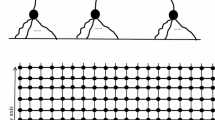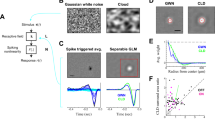Abstract
A striking feature of the organization of the early visual pathway is the significant feedback from primary visual cortex to cells in the dorsal lateral geniculate nucleus (LGN). Despite numerous experimental and modeling studies, the functional role for this feedback remains elusive. We present a new firing-rate-based model for LGN relay cells in cat, explicitly accounting for thalamocortical loop effects. The established DOG model, here assumed to account for the spatial aspects of the feedforward processing of visual stimuli, is extended to incorporate the influence of thalamocortical loops including a full set of orientation-selective cortical cell populations. Assuming a phase-reversed push-pull arrangement of ON and OFF cortical feedback as seen experimentally, this extended DOG (eDOG) model exhibits linear firing properties despite non-linear firing characteristics of the corticothalamic cells. The spatiotemporal receptive field of the eDOG model has a simple algebraic structure in Fourier space, while the real-space receptive field, as well as responses to visual stimuli, are found by evaluation of an integral. As an example application we use the eDOG model to study effects of cortical feedback on responses to flashing circular spots and patch-grating stimuli and find that the eDOG model can qualitatively account for experimental findings.






Similar content being viewed by others
References
Abramowitz M, Stegun I (1965) Handbook of mathematical functions. Dover, New York
Ahlsén G, Grant K, Lindström S (1982) Monosynaptic excitation of principal cells in the lateral geniculate nucleus by corticofugal fibers. Brain Res 234:454–458
Andolina I, Wang W, Jones H, Salt T, Sillito A (2002) Effects of feedback on cat lgn cell spatial summation parameters dissected with the difference of gaussian model (DOGM). In: Society for neuroscience abstract, vol 32. Society for Neuroscience, Washington, DC, p 352.17
Andolina I, Jones H, Wang W, Sillito A (2007) Corticothalamic feedback enhances stimulus response precision in the visual system. Proc Natl Acad Sci 104:1685–1690
Bracewell R (1986) The Fourier transform and its applications. McGraw-Hill, New York
Briggs F, Usrey W (2007) A fast, reciprocal pathway between the lateral geniculate nucleus and visual cortex in the macaque monkey. J Neurosci 27:5431–5436
Briggs F, Usrey W (2008) Emerging views of corticothalamic functionemerging views of corticothalamic function. Curr Opin Neurobiol 18:403–407
Briggs F, Usrey W (2009) Parallel processing in the corticogeniculate pathway of the macaque monkey. Neuron 62:135–146
Briggs F, Usrey W (2011) Corticogeniculate feedback and visual processing in the primate. J Physiol 589:33–40
Cheng H, Chino Y, Smith IE, Hamamoto J, Yoshida K (1995) Transfer characteristics of lateral geniculate nucleus X neurons in the cat: effects of spatial frequency and contrast. J Neurophysiol 74:2548–2557
Cudeiro J, Sillito A (1996) Spatial frequency tuning of orientation-discontinuity-sensitive corticofugal feedback to the cat lateral geniculate nucleus. J Physiol 490:481–492
Dayan P, Abbott L (2001) Theoretical neuroscience. MIT Press, Cambridge
Destexhe A (2000) Modelling corticothalamic feedback and the gating of the thalamus by the cerebral cortex. J Physiol (Paris) 94:391–410
Destexhe A, Contreras D, Steriade M (1998) Mechanisms underlying the synchronizing action of corticothalamic feedback through inhibition of thalamic relay cells. J Neurophysiol 79:999–1016
Einevoll G, Heggelund P (2000) Mathematical models for the spatial receptive-field organization of nonlagged X cells in dorsal lateral geniculate nucleus of cat. Vis Neurosci 17:871–886
Einevoll G, Plesser H (2002) Linear mechanistic models for the dorsal lateral geniculate nucleus of cat probed using drifting-grating stimuli. Netw Comp Neur Syst 13:503–530
Einevoll G, Plesser H (2003) Extended DOG receptive-field model for LGN relay cells incorporating cortical-feedback effects. In: Society for Neuroscience Abstracts, vol 33. Society for Neuroscience, Washington, DC, p 68.11
Einevoll G, Plesser H (2005) Response of the difference-of-gaussians model to circular drifting-grating patches. Vis Neurosci 22:437–446
Geisert E, Langsetmo A, Spear P (1981) Influence of the cortico-geniculate pathway on response properties of cat lateral geniculate neurons. Brain Res 208:409–415
Godwin D, Vaughan J, Sherman S (1996) Metabotropic glutamate receptors switch visual response mode of lateral geniculate cells from burst to tonic. J Neurophysiol 76:1800–1816
Grieve K, Sillito A (1995) Differential properties of cells in the feline primary visual cortex providing the corticofugal feedback to the lateral geniculate nucleus and visual claustrum. J Neurosci 15:4868–4874
Hayot F, Tranchina D (2001) Modeling corticofugal feedback and the sensitivity of lateral geniculate neurons to orientation discontinuity. Vis Neurosci 18:865–877
Heeger D (1991) Nonlinear model of neural responses in cat visual cortex. In: Landy M, Movshon J (eds) Computational models of visual processing, MIT Press, Cambridge, pp 119–134
Hillenbrand U, van Hemmen L (2000) Spatiotemporal adaptation through corticothalamic loops: a hypothesis. Vis Neurosci 17:107–118
Hubel D, Wiesel T (1962) Receptive fields, binocular interaction and functional architecture in the cat’s visual cortex. J Physiol 160:106–154
Jing W, Liu W-Z, Gong X-W, Gong H-Q, Liang P-J (2010) Visual pattern recognition based on spatio-temporal patterns of retinal ganglion cells’ activities. Cogn Neurodyn 3:179–188
Jones H, Andolina I, Oakely N, Murphy P, Sillito A (2000) Spatial summation in lateral geniculate nucleus and visual cortex. Exp Brain Res 135:279–284
Kirkland K, Gerstein G (1998) A model of cortically induced synchronization in the lateral geniculate nucleus of the cat: a role for low-threshold calcium channels. Vis Res 38:2007–2022
Kirkland K, Sillito A, Jones H, West D, Gerstein G (2000) Oscillations and long-lasting correlations in a model of the lateral geniculate nucleus and visual cortex. J Neurophysiol 84:1863–1868
Köhn J, Wörgötter F (1996) Corticofugal feedback can reduce the visual latency of responses to visual stimuli. Biol Cybern 75:199–209
Liang L, Wang R, Zhang Z (2010) The modeling and simulation of visuospatial working memory. Cogn Neurodyn 4:359–366
Marrocco R, McClurkin J, Young R (1982) Modulation of lateral geniculate nucleus cell responsiveness by visual activation of the corticogeniculate pathway. J Neurosci 2:256–263
Marrocco R, McClurkin J, Alkire M (1996) The influence of the visual cortex on the spatiotemporal response properties of lateral geniculate cells. Brain Res 737:110–118
Mayer J, Schuster H, Claussen J, Mölle M (2007) Corticothalamic projections control synchronization in locally coupled bistable thalamic oscillators. Phys Rev Lett 99:68–102
McClurkin J, Marrocco R (1984) Cortical input to the monkey lateral geniculate nucleus alters visual spatial tuning in monkey lateral geniculate nucleus cells. J Physiol (Lond) 348:135–152
McClurkin J, Optican L, Richmond B (1994) Cortical feedback increases visual information transmitted by monkey parvocellular lateral geniculate nucleus neurons. Vis Neurosci 11:601–617
McCormick D, von Krosigk M (1992) Corticothalamic activation modulates thalamic firing through glutamate “metabotropic” receptors. Proc Nat Acad Sci 89:2774–2778
Murphy P, Sillito A (1987) Corticofugal feedback influences the generation of length tuning in the visual pathway. Nature 329:727–729
Murphy P, Sillito A (1996) Functional morphology of the feedback pathway from area 17 of the cat visual cortex to the lateral geniculate nucleus. J Neurosci 16:1180–1192
Murphy P, Duckett S, Sillito A (1999) Feedback connections to the lateral geniculate nucleus and cortical response properties. Science 286:1552–1554
Norheim E, Wyller J, Nordlie E, Einevoll G (2011) Feedback and feedforward contributions to temporal signal processing in the lateral geniculate nucleus. Cogn Neurodyn (submitted)
Reid C, Alonso JM (1995) Specificity of monosynaptic connections from thalamus to visual cortex. Nature 378:281–284
Rodieck R (1965) Quantitative analysis of cat retinal ganglion cell response to visual stimuli. Vis Res 5:583–601
Saglam M, Hayashida Y, Murayama N (2009) A retinal circuit model accounting for wide-field amacrine cells. Cogn Neurodyn 1:25–32
Sherman S, Guillery R (2001) Exploring the thalamus. Academic Press, New York
Sillito A, Jones H (2002) Corticothalamic interactions in the transfer of visual information. Phil Trans R Soc Lond B 357:1739–1752
Sillito A, Jones H (2004) Feedback systems in visual processing. In: The visual neurosciences, vol 1, MIT Press, Cambridge, pp 609–624
Sillito A, Cudeiro J, Murphy P (1993) Orientation sensitive elements in the corticofugal influence on centre-surround interactions in the dorsal lateral geniculate nucleus. Exp Brain Res 93:6–16
Sillito A, Jones H, Gerstein G, West D (1994) Feature-linked synchronization of thalamic relay cell firing induced by feedback from the visual cortex. Nature 369:479–482
So Y, Shapley R (1981) Spatial tuning of cells in and around lateral geniculate nucleus of the cat: X and Y relay cells and perigeniculate interneurons. J Neurophys 45:107–120
Troyer T, Krukowski A, Priebe N, Miller K (1998) Contrast-invariant orientation tuning in cat visual cortex: thalamocortical input tuning and correlation-based intracortical connectivity. J Neurosci 18:5908–5927
Troyer T, Krukowski A, Miller K (2002) LGN input to simple cells and contrast-invariant orientation tuning: an analysis. J Neurophysiol 87:2741–2752
Vidyasagar T, Urbas J (1982) Orientation sensitivity of cat LGN neurones with and without inputs from visual cortical areas 17 and 18. Exp Brain Res 46:157–169
Wang R, Zhang Z (2007) Energy coding in biological neural networks. Cogn Neurodyn 3:203–212
Wang W, Jones H, Andolina I, Salt T, Sillito A (2006) Functional alignment of feedback effects from visual cortex to thalamus. Nature Neurosci 9:1330–1336
Weber A, Kalil R, Behan M (1989) Synaptic connections between corticogeniculate axons and interneurons in the dorsal lateral geniculate nucleus of the cat. J Comp Neurol 289:156–164
Wörgötter F, Nelle E, Li B, Funke K (1998) The influence of corticofugal feedback on the temporal structure of visual response of cat thalamic relay cells. J Physiol 509:797–815
Yousif N, Denham M (2007) The role of cortical feedback in the generation of the temporal receptive field responses of lateral geniculate nucleus neurons: a computational study. Biol Cybern 97:269–277
Acknowledgments
We are grateful to Eivind S. Norheim for carefully reading the manuscript. Partially supported by the eVita program of the Research Council of Norway under grant 178892/V30 and the Honda Research Institute Europe GmbH.
Author information
Authors and Affiliations
Corresponding author
Appendices
Appendix 1: eDOG model for small cortical feedback strengths
For \(|C|<1\), the denominator term of the integral expression for f eDOG(r) in Eq. 35 can be replaced by a series expansion, i.e., \(1/(1-x)= \sum_{m=0}^\infty x^m = 1 + x + x^2 + \ldots\). With \(x = C e^{-k^2 c^2/4}\) we find by insertion into Eq. 35:
The final expression in Eq. 40 has a relatively simple form: it consists of an infinite sum of DOGs. For small values of C, the higher terms vanish rapidly, so that only a limited number of terms need to be retained. The terms in the sum have increasing spatial extent (\(\sqrt{a_1^2 + mc^2}, \sqrt{a_2^2 + mc^2}\)) and alternating sign when C is negative.
The terms in the series have an intuitive interpretation as illustrated by the first three terms:
The first term corresponds to the “direct” feedforward DOG. The second term corresponds to the correction to this “direct” term due to one round of the feedforward DOG in the cortical feedback loop. The spatial extension of the Gaussians is larger since they have been ”spread out” by the spatial spread of the corticogeniculate loop. Correspondingly, the third term corresponds to a “correction of the correction” after the direct term has gone through the thalamocortical loop twice. This term is spatially even more spread out after two rounds through the loop.
For \(|C|<1\), the series in Eq. 40 can be shown to be uniformly convergent assuring the validity of the mathematical derivation. If the feedback is positive with C = 1, the integrand in Eq. 35 has a singular point corresponding to a resonance in the thalamocortical loop (Einevoll and Plesser 2002).
Appendix 2: Numerical methods
Figures 2, 3 were created using Mathematica 7 (Wolfram Research), while Figs. 4, 6 were created using Matlab 7.10.0 (MathWorks) on a Lenovo T410i computer running Windows XP.
Rights and permissions
About this article
Cite this article
Einevoll, G.T., Plesser, H.E. Extended difference-of-Gaussians model incorporating cortical feedback for relay cells in the lateral geniculate nucleus of cat. Cogn Neurodyn 6, 307–324 (2012). https://doi.org/10.1007/s11571-011-9183-8
Received:
Revised:
Accepted:
Published:
Issue Date:
DOI: https://doi.org/10.1007/s11571-011-9183-8




